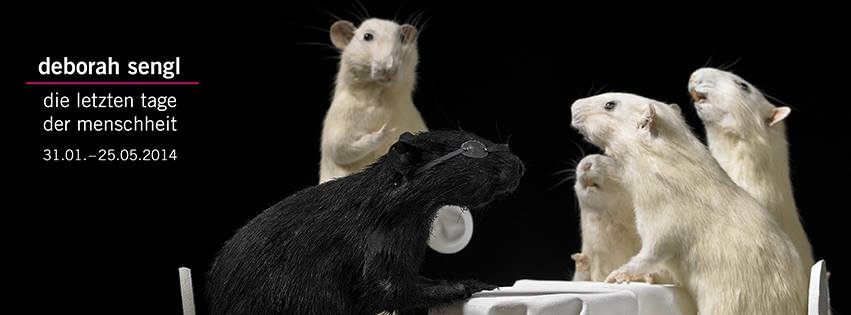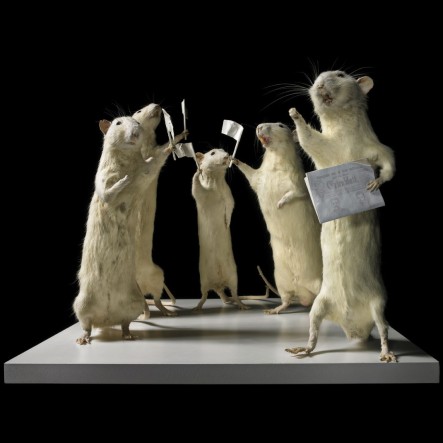
31.01.–25.05.2014
Opening: 30.01.2014, 19.30
by the Federal President Dr. Heinz Fischer
Curators: Andreas Hoffer, Günther Oberhollenzer

For her first museum presentation the Austrian artist Deborah Sengl has created an installation that combines history, literature and contemporary art in an extraordinary way. With some 200 stuffed white rats, she is staging The Last Days of Mankind after Karl Kraus in 44 individual scenes.
The First World War and 200 Rats
2014 marks the 100th anniversary of the outbreak of the First World War. Probably hardly any other literary work has captured the atmosphere of the time and the inhumanity and absurdity of war as precisely as The Last Days of Mankind (1915-1922) by Karl Kraus. In her so far largest work Sengl reacts to Kraus’s text with unmistakeable feeling and artistically reinterprets excerpts of scenes and dialogues. Accompanied by drawings and paintings, they bring the protagonists of Kraus’s work to life. Deborah Sengl has spent a year working on this elaborate project, which has been created specially for the Essl Museum. It is based on the stage version of The Last Days of Mankind.
“Both of us observe from the outside and document what we see,” says Sengl of her relationship with Karl Kraus. “I actually always portray only what I experience, what I see in our time, in our society. I don’t invent any extras. Neither did Karl Kraus. The Last Days is actually a collection of quotes and of the spoken word.” Sengl sees her work as a “free artistic interpretation of Kraus’s work, although she discovered a great deal that is topical and contemporary in it : “The work may be a century old, but for me it is still up to date. We may not have a war in the immediate vicinity, but war is still so strongly present in us as it was then, if not more so.” In the choice of scenes (41 scenes and three monumental apocalyptic scenes) the artist attempted to put together a cross-section of the various theatres of action. They range from street and court scenes, through hospitals to the horrors of the battlefields.
Karl Kraus in a new disguise
Deborah Sengl works closely with a taxidermist, who prepares the rat skins for her on the basis of precise specifications. The animals have not been killed for the artistic work – these are feed-rats that are kept for breeding birds of prey and reptiles: “The decision on the rats was relatively quick, because I find that they are similar to people. They are certainly the most selfish animals, they always think of themselves first.” Sengl explains that she chose white rats because she did not want to create any hierarchies or ratings. As Karl Klaus also described it, all share the guilt in the war, the soldiers, who murder, but also the propagandist press or the civilians, who do not resist is, who spread and repeat opinions. In the closing scene Karl Kraus admits his own complicity. Nevertheless, Sengl decided to have the “Grumbler” appear as a black rat, as he is the person who observes the events from outside. In meticulous detail work, Sengl designs flags and newspapers, furniture and other objects such as hats or jewellery to bring the protagonists to life and make the individual scenes recognisable and readable. All the props are white, but in occasional scenes there is blood, urine and alcohol as a coloured method of illustrating that the horror is increasingly breaking into everyday life and that this “purity” is being broken.
Deborah Sengl studied with Christian Ludwig Attersee. She lives and works in Vienna. In her paintings, drawings and sculptures she transfers questions about identity and masquerade into the animal world and scrutinises role behaviour in human society. “I therefore use the animal as a metaphor, because I find that it is distracting when one portrays people. One distracts with the physiognomy; everyone starts to have a subjective view of these people.” With an animal this is not the case, says Sengl: “it is only a proxy for a characteristic trait, for a form of action, for a behaviour.” The work for the Essl Museum is a logical further development of this theme. In the process Sengl achieves a courageous artistic view of Kraus’s work and allows us to rediscover its topicality.
The exhibition opens the Essl Museum’s exhibition programme for 2014, which is under the motto
>made in austria<.
